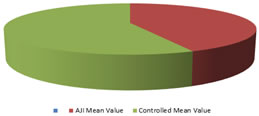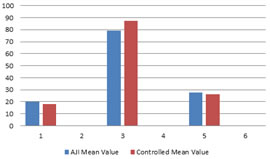|
Table of Content - Volume 15 Issue 3 - September 2020
Study of serum calcium levels in relation to ankle joint instability patients in Andhra Pradesh population
Sujit Ravi Teja1*, Srinivasa Rao Puli2
1Assistant Professor, Department of Orthopedics, Nimra Medical College, ibrahimpatnam, Andhra Pradesh-521456. INDIA. 2Assistant professor, Department of Orthopedics, Narayana Medical College, Nellore, Andhra Pradesh-524002. INDIA. Email: tejatpc@gmail.com
Abstract Background: Ankle joint contributes stability and formation of joint is multifunctional mainly mineral contents like Serum calcium which maintains density and prevents osteoporosis which leads to fractures and instability of joint. Method: 90 patients having instability of ankle joint compared with 90 controlled group. Age of both group was 23 to 45 years. Serum calcium, was studied and radiology of ankle joint was also studied, in both group and compared. Results: Mean value of AJI of Sr. calcium was 9.30 (SD± 1.4) and controlled group was 12.1 (SD± 1.2) t test was -14.4 and p<0.001. In the radiological study osseous parameters were. In radial range of Ankle joint mean value of AJI group was 20.2 (SD± 2.3) and controlled group was 18.1 (SD± 1.8) t test was 6.8 p<0.001. Sector of ankle joint in AJI group mean value was 79.2 (SD± 4.1) and controlled group was 87.3 (SD± 6.2) t test was -10.3 p<0.00. Height of Talus – Mean value in AJI group was 27.7 (SD± 1.9) and controlled group was 26.4 (SD± 3.0)t test was 3.4 p<0.005. Conclusion: This pragmatic approach of Sr. Calcium levels and osseous parameters in radiology will be quite helpful to orthopedic surgeon, radiologist to treat such patients efficiently to avoid morbidity and mortality because Sr. calcium levels in bones forming joint is an global problem. Key Words: AJI(Ankle Joint Instability), Sr. Calcium, Osseous parameters, Dietary Supplements, Hormones.
INTRODUCTION Ankle joint instability is quite common phenomenon characterized by sports and recreational activities1. The anterior talofibular2 ligament is affected in 85% of ankle sprains. This type of injury represents sprain with3 a major component in sagittal plane. The average intake of calcium must be 700-900 mg/day but clinical trials have of calcium supplements at doses of 1000 mg/day. However Cardio-vascular side effects4 and Kidney stones and acute Gastro-intestinal symptoms(5) were also reported. Hence it is mandatory to know the calcium levels especially those who are prone for fractures, joint instability. Otherwise it may cause secondary infections and may lead to morbidity and mortality.
MATERIAL AND METHOD 90 (Ninety Patients) who were regularly visiting Orthopedic Department, Nimra Medical College Hospital – Ibrahimpatnam (Andhra Pradesh) 521456 were studied.
OBSERVATION AND RESULTS Table 1: In the serum calcium mean value 1.30 (SD±1.4) in Ankle Joint Instability(AJI) patients, 12.1 (SD±1.2) mean value in controlled groups t test value was -14.4 and p value was highly significance(p<0.001). Table 2: Osseous parameters in radiological study – In the radial range of ankle joint 20.2 mm (SD±2.3) mean value in AJI group. 18.1 mm (SD±1.8) mean value in controlled group t test value was 6.8 and p value was highly significant (p<0.01). In the sector of Ankle joint study 79.2 (SD±4.1) digits in AJI group and 87.3 (SD±6.2) t test value was -10.3 and p value was highly significant (p<0.01). Height of Talus 27.7 (SD±1.9) mean value in AJI group, 26.4 (SD±3.0) mean value in controlled group t test value was 3.4 and p value was significant (p<0.05).
Table 1: Study of Calcium levels in both groups
AJI- Ankle Joint Instability
Figure 1: Study of Calcium levels in both groups
Table 2: Radiological study of ankle in both groups (Osseous Parameters)
AJI- Ankle Joint Instability
Figure 2: Radiological study of ankle in both groups (Osseous Parameters) DISCUSSION In the present study of serum calcium levels in relation to Ankle joint instability patients in Andhra Pradesh population. The serum calcium levels mean value in AJI group was 9.30 (SD±1.4) and 12.1 (SD±1.2) in controlled group t test value was -14.4 and p value was highly significant (p<0.001). In the radiological study of osseous parameters – mean value in AJI group was 20.2 (SD±2.3), 18.1 t test value was 6.8 and p value was highly significant (p<0.001), mean value of sector of ankle joint in AJI group was 79.2 (SD±4.1), 87.3 (SD±6.2) in controlled group t value was -10.3 and p value was highly significant (p<0.01), mean value of height of Talus in AJI group was 27.7 (SD±1.9), 26.4 (SD±3.0) in controlled group t test value was 3.4 and p value was significant (p<0.05). These findings were more or less in agreement with previous studies6,7,8 It is reported that especially nerve and muscle cells do not function properly unless they are bathed in the fluid whose calcium concentration does not fall below or above 11mg calcium per 100cm3. If the concentration in the blood stream tends to fall then calcium is immediately and automatically withdrawn from exchangeable pool in the bones vice-versa. Parathhormone is a powerful hormone and if parathyroid hormone activity is abnormally high, skeleton melts away and its component are lost in urine. Normal growth of bone is dependent on anterior pituitary which stimulates cell division in the cartilaginous growth plates at the end of bones, however it is ineffective in the absence of sufficient thyroxin. The normalcy of content of calcium is influenced not only by age and sex but by economic status, individual total body weight and also possible by physical activity.9 Racial differences are taken into account but is very difficult to obtain reliable evidence on this point. Hence it may related to nutritional climatic and other factors10 Apart from calcium vitamin A also controls activity, distribution and co-ordination of the osteoblastic and osteoclastic activity to the sites where it is normally found and the reaction is often of very intense nature. Hence dietary supplement contains calcium (Vitamin D), Vitamin A, also play vital role in the joint stability. Risk of spraining of ankle joint depends on both intrinsic factors like hind foot alignment, laxity of ligaments, muscular co-ordination, neuro-muscular control and extrinsic factors involve shoe worn type and intensity of sports, warm-up etc.11 but rapid recovery depends on normalcy in bone mineralization and vascularity.
SUMMARY AND CONCLUSION Ankle joint is one of the main weight bearing of body hence it needs lot of factors to stabilize its proper functioning. Calcium is proved to be one of the main mineral to maintain the density of the bones of ankle joint but this study further demands nutritional genetic hormonal, embryological, patho-physiological study because exact factors which determine the time of ossification are still obscure. This research paper was approved by ethical committee of Nimra Medical College, Jupudi-521456. Andhra Pradesh
REFERENCES
.
Policy for Articles with Open Access: Authors who publish with MedPulse International Journal of Forensic Medicine (Print ISSN: 2579-0935) (Online ISSN: 2636-4735) agree to the following terms: Authors retain copyright and grant the journal right of first publication with the work simultaneously licensed under a Creative Commons Attribution License that allows others to share the work with an acknowledgement of the work's authorship and initial publication in this journal. Authors are permitted and encouraged to post links to their work online (e.g., in institutional repositories or on their website) prior to and during the submission process, as it can lead to productive exchanges, as well as earlier and greater citation of published work.
|
|
 Home
Home


